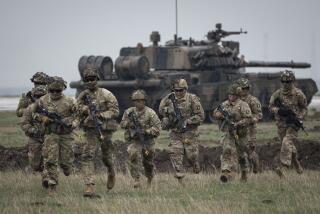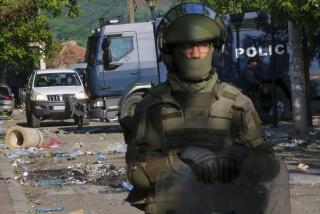U.S. Copters Begin Arriving in Albania
- Share via
WASHINGTON — Despite four weeks of bombardment, Yugoslavia’s air-defense system in Kosovo is still largely intact, hampering NATO operations and limiting the usefulness of the Apache helicopters that began arriving in Albania on Wednesday to escalate attacks on Serbian ground forces.
With the Yugoslavs holding air-defense weapons in reserve for later use, the tank-busting Apaches--meant to target the forces that are terrorizing Kosovo’s ethnic Albanians--may not be sent into battle for days or even weeks because of the continuing risk to low-flying craft.
“The risk is still very much there,” one U.S. defense official said. The Apache “is not a silver bullet.”
Added Sen. Carl Levin (D-Mich.), an administration ally who was briefed over the weekend in Europe by NATO commanders: “Do not expect substantial results from the Apache for quite some time.”
Air defenses have been a top NATO target since the air campaign began, and alliance officials say they have made substantial progress in some areas.
But Yugoslav President Slobodan Milosevic has opted not to use his defense weaponry to the utmost, making it harder for allied planes to find and target his equipment. This approach contrasts with that used by Iraqi President Saddam Hussein, who aggressively responded to allied air attacks during the 1991 Persian Gulf War but lost most of his defenses in the process.
The Yugoslavs have managed to shoot down only one allied plane--a F-117A Stealth fighter brought down March 27--but have preserved the threat posed by a potent antiaircraft system.
NATO officials say allied airstrikes have managed to bash command posts and sever communications links between air-defense radars and missiles, so that air defenses no longer function as an integrated system. And, using radar-jamming planes, especially the EA-6B Prowler, NATO has been able to temporarily disable air-defense radars so that warplanes can fly through any part of the province.
Yet after more than 7,000 sorties, allied planes and missiles have destroyed only five air-defense facilities and inflicted “severe damage” on four others, NATO said. They have inflicted “moderate” damage on 21 more, a designation that means the facilities may still be operational.
NATO aircraft are vulnerable in several other ways.
They can still be hit at low altitudes by antiaircraft artillery, and by the shoulder-mounted heat-seeking missiles, which are akin to the U.S.-made Stingers that became well-known in the Afghan war.
At higher altitudes, the planes may have at least some vulnerability to the mobile SA-3 and SA-6 surface-to-air missiles.
Pentagon officials have said that the Serbs have been firing SA-3 and SA-6 missile batteries “ballistically”--without radar guidance. Used this way, they are not highly effective.
But Yugoslavia’s military communications system was built to include extra communications lines. And it is possible, experts say, that the Serbs have been able to provide some tracking data to the missile batteries.
This would be bad news for the Apache.
It flies at only 150 mph, at altitudes of several hundred feet or less.
In a typical operation, the helicopter will hover behind hilltops until mobile rocket batteries have sprayed the terrain ahead with cluster bombs to clear away any threat. The Apache gained a reputation in the 1991 Persian Gulf War as a tank killer, and it can fire rockets from a distance of five miles.
Even so, defense officials acknowledge that Apaches can be downed by even a heavy-caliber machine gun.
And the Kosovo terrain poses special risks: Yugoslav troops and security police are dispersed to the point where there are no real battle lines. Concealed under trees and in rough terrain, they may be able to shoot at passing Apaches the way that Afghan fighters shot at Soviet helicopters during the 1980s conflict.
For these reasons, military experts say they expect that NATO forces will be carefully gathering intelligence on what lies on the ground before the Apaches go into battle.
Indeed, there has been speculation that NATO special operations troops may be at work inside Kosovo gathering information on the disposition of field forces, in part to help the Apaches’ mission. Earlier this week, a member of Canada’s Parliament told reporters that a Canadian special forces team had been at work inside the province.
In Albania, where the first 12 black Apaches arrived Wednesday in Tirana, the capital, U.S. Army Capt. Mark Arden said: “We’re taking all precautions possible to minimize those risks.”
Yet Levin, who is the ranking minority member of the Senate Armed Services Committee, said earlier this week that he believes the risks “are significant--and will remain significant.” As a result, he said, the Apaches will be brought in “on a gradual basis.”
“Don’t expect [that] this is going to produce any quick answer to ethnic cleansing,” Levin said.
More to Read
Sign up for Essential California
The most important California stories and recommendations in your inbox every morning.
You may occasionally receive promotional content from the Los Angeles Times.














